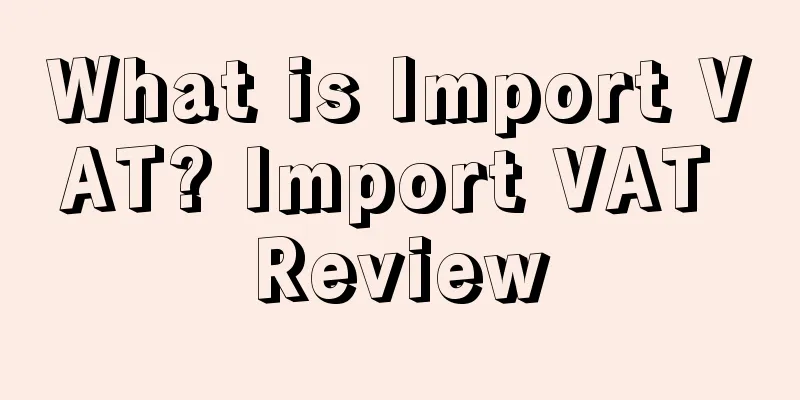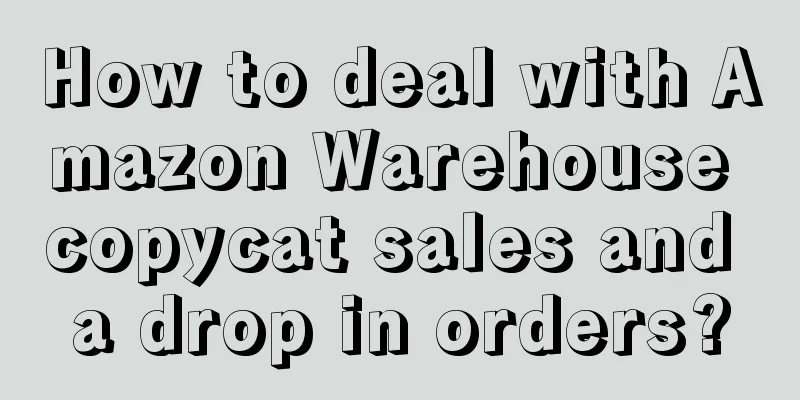What is Import VAT? Import VAT Review

|
Import VAT refers to the VAT collected at the import stage, which is a kind of turnover tax. Unlike general VAT, which is levied on the value-added amount in production, wholesale, retail and other stages, import VAT is a kind of VAT that is levied on the value-added amount in the import stage. Chinese name: Import VAT formula (tax-paid price + tariff) / (1-consumption tax rate) * VAT rate collection scope: All goods declared to enter the territory of China's customs 1. Calculation method According to my country's tax law, taxpayers who import goods shall calculate the tax payable based on the taxable price and the prescribed VAT rate, and shall not deduct any tax (when calculating the VAT payable at the import stage, various taxes incurred outside my country shall not be deducted). The formula for calculating the taxable price and tax payable is: Taxable price = duty-paid price + tariff + consumption tax Tax payable = taxable price x tax rate It should be noted that the taxable price of the value-added tax on imported goods already includes the amount of customs duties paid. If the imported goods are taxable consumer goods subject to consumption tax, their taxable price must also include the amount of consumption tax paid at the import stage. Import VAT calculation formula: Import VAT = (duty-paid price + tariff) / (1-consumption tax rate) × VAT rate 1. When declaring customs, the customs broker must fill in the name of the declared goods and the tax number on the customs declaration application form. 2. After the customs review, the import duties and VAT to be collected will be calculated based on the tax rate corresponding to the tax number. The tax collected by the customs consists of two parts: 1) Import tariffs 2) Collection of value-added tax For example, if you import a machine worth 10,000 USD, the machine has a tax number of 84131100 according to the customs tariff. The import tariff rate is 12% and the VAT rate is 17%. How much tax do you need to pay for importing this machine? First, the customs converts the declared foreign exchange into RMB based on the exchange rate on the day when the customs special payment slip is issued. The exchange rate on December 2, 1999 was USD1=RMB8.2785000, so the import price of this machine worth 10,000 USD is RMB 82,785, which is also the "duty-paid price" for calculating the import tariff. The tax amount of import tariff = the dutiable price of import tariff x import tariff rate = 82,785x12% = 9,934.20 yuan. While collecting import tariffs, the customs also has to collect value-added tax on behalf of the machine. The value-added tax rate for this machine is 17%. Please note that the VAT to be paid is not 82,785x17% because the dutiable price for VAT collection is not the dutiable price for import duties. The dutiable price for VAT collection = the dutiable price for import duties + the tax amount for import duties = 82,785 + 9,934.20 = 92,719 yuan. The amount of VAT collected = the taxable price x VAT rate = 92,719 x 17% = 15,762.23 yuan. Therefore, the total tax to be paid for importing this machine = 9,934.20 + 15,762.23 = 25,696.43 yuan. 2. Deduction Process 1. General VAT taxpayers who import goods and obtain customs payment slips that fall within the scope of VAT deduction shall submit the "Customs Duty Payment Certificate Deduction List" (including paper materials and electronic data, hereinafter referred to as the "Deduction List") to the competent tax authorities for audit and comparison within 180 days if issued before July 1, 2017, and within 360 days if issued on or after July 1, 2017. If audit and comparison are not applied for within the prescribed time limit, the input tax amount will not be deducted. 2. During the monthly declaration period, the tax authorities shall provide taxpayers with the "Notice of Audit Result of Customs Import VAT Special Payment Receipt" (hereinafter referred to as the "Audit Result Notice") for the previous month. For customs payment slips with consistent audit results, taxpayers should apply for deduction within the declaration period of the month when the tax authorities provide the audit results. No deduction will be allowed after the deadline. For customs payment receipts that are found to be inconsistent, missing, or duplicate in the audit results, taxpayers should check them one by one based on the original customs payment receipts and handle them according to the following requirements based on the circumstances: (I) If the taxpayer's information is collected incorrectly, the taxpayer may apply for data modification in the month when the competent tax authority provides the audit results, and conduct another audit and comparison. The tax authority will provide the audit and comparison results to the taxpayer during the declaration period of the next month. If the taxpayer fails to apply for data modification within the deadline, the input tax amount will not be deducted. 1. If the taxpayer re-collects data within the reporting period (90 days from the date of issuance of the customs payment receipt), the data can be re-collected through the enterprise electronic tax declaration management system (hereinafter referred to as the electronic declaration software) and submitted to the competent tax authority for re-audit and comparison. 2. If the time for taxpayers to re-collect data has exceeded the submission deadline, they can fill out the "Application Form for Verification of Customs Import VAT Special Payment Receipts for Audit Abnormalities" to the competent tax authority in the month when the competent tax authority provides the audit results and apply for data modification and re-audit and comparison. (II) If the taxpayer still requests to apply for a tax deduction even though the collection is not wrong, the competent tax authority shall organize an audit and inspection. If the face information of the customs payment slip is consistent with the taxpayer's actual import business, the taxpayer shall apply for a tax deduction within the declaration period of the next month after receiving the written notice from the tax authority. No tax deduction will be granted after the deadline. 3. Taxpayers should set up a detailed account of "Input tax to be deducted" under the account of "Taxes payable" to calculate the input tax on the customs payment slip for which the taxpayer has applied for audit but has not yet obtained the audit result. After the taxpayer obtains the customs payment slip, the detailed account of "Taxes payable--Input tax to be deducted" should be debited and the relevant accounts should be credited; if the audit is consistent and the deduction is allowed after verification, the column of "Taxes payable--VAT payable (input tax)" should be debited and the account of "Taxes payable--Input tax to be deducted" should be credited. For the input tax that cannot be deducted after verification, the "Taxes payable--Input tax to be deducted" should be debited in red and the relevant accounts should be credited in red. IV. Adjustment of VAT return form and “one-window” comparison items: (I) During the declaration period in April 2009, general taxpayers who are not in the coaching period shall still declare the customs payment slip for the tax deduction period of March 2009 in accordance with the relevant provisions of the "Notice of the State Administration of Taxation on Strengthening the Management of Customs Import VAT Special Payment Receipts and Invoices for Waste and Used Materials" (State Taxation Bureau Letter [2004] No. 128) and submit the "Deduction List". (II) General taxpayers of commercial enterprises in the guidance period shall, in the April 2009 tax declaration period, still submit a list of customs payment receipts to be deducted in accordance with the relevant provisions of the "Urgent Notice of the State Administration of Taxation on Strengthening the Management of Value-Added Tax Collection from Newly Established Commercial Enterprises" (State Taxation Bureau Notice [2004] No. 37) and other relevant regulations, and declare the deduction of the customs payment receipts that are consistent with the audit and comparison in March 2009. (III) Starting from the declaration period in May 2009, taxpayers can download the "Audit Result Notice" and the list through the tax service hall of the competent tax authority or the online tax service hall during the declaration period, and import the list data into the electronic declaration software for declaration and deduction. Among them: the input tax amount of the customs payment slip that has been applied for audit but has not yet obtained the audit result should be filled in the "Value Added Tax Return". III. Scope of Taxation All goods declared to enter the territory of our country’s customs. As long as the taxable goods are declared for import, no matter whether they are produced abroad or exported from my country but resold domestically, whether they are purchased by the importer themselves or donated from abroad, whether they are used by the importer for his own use or for trade or other purposes, value-added tax should be paid at the import stage in accordance with regulations. 4. Import Deduction Content: I would like to ask the following questions: 1. Where can I download the Customs Import VAT Certification and Deduction Collection System? 2. Our company mainly processes with supplied materials and occasionally with imported materials. Can the import VAT paid on consumables imported from abroad (not listed in the manual) be included in the taxes payable - input tax? 3. If the import VAT can be deducted, what information should be submitted to the tax bureau? Reply content: 1. The Customs Import VAT Certification and Deduction Collection System can be downloaded from two places: one is the State Administration of Taxation website - Download Service Center - Software Download - Customs Duty Payment Certificate Deduction List Collection Software Download; the other is Online Declaration - Login - Software Download - Customs Duty Payment Certificate Deduction List Collection Software Download. 2. For goods under general trade, the value-added tax that has been collected and paid by the customs on import can be declared deductible. 3. The declaration and deduction of customs import value-added tax should be filed with the competent tax authority after signing the contract. The deduction can be declared after obtaining the customs tax payment certificate, but no later than 180 days. 5. How to deduct According to the provisions of Appendix 1 "Auditing Methods for Customs Import VAT Special Payment Receipts" of the "Notice of the State Administration of Taxation on Strengthening the Management of Customs Import VAT Special Payment Receipts and Invoices for Waste and Used Materials" (State Taxation Bureau [2004] 128): General VAT taxpayers who obtain customs tax payment receipts issued after February 1, 2004 must report them to the competent tax authorities for deduction before the end of the first declaration period after 180 days from the date of issuance. No input tax can be deducted after the deadline. According to the Notice of the State Administration of Taxation on the deduction of input tax by general VAT taxpayers who obtain special customs import VAT payment receipts (Guo Shui Fa [2004] 148): For taxpayers who import goods and have paid the import VAT, regardless of whether they have paid for the goods, the customs tax payment receipts they obtain can be used as vouchers for deduction of input VAT. VI. Related documents Notice of the State Administration of Taxation on Adjusting the Deduction Period of VAT Deduction Certificates To the State Taxation Bureaus of all provinces, autonomous regions, municipalities directly under the Central Government and cities with independent planning status: Since 2003, the State Administration of Taxation has successively implemented a 90-day reporting and deduction period for VAT special invoices and other tax deduction vouchers, which has played a positive role in improving the operation quality of the VAT collection and management information system and urging taxpayers to report in time. Recently, some taxpayers and tax authorities have reported that the 90-day reporting and deduction period is too short, and some taxpayers cannot deduct input tax due to overdue reporting of tax deduction vouchers. In order to reasonably solve the actual problems of taxpayers and strengthen tax collection and management, after research, the following notice is hereby issued on the relevant issues: 1. General VAT taxpayers who obtain special VAT invoices, unified invoices for road and inland waterway freight transportation, and unified invoices for motor vehicle sales issued after January 1, 2010, should go to the tax authorities for certification within 180 days from the date of issuance, and report the deduction of input tax to the competent tax authorities during the declaration period of the next month after the certification is passed. 2. General VAT taxpayers who implement the management method of "first comparison and then deduction" for the customs import VAT special payment slip (hereinafter referred to as the customs payment slip) and obtain the customs payment slip issued after January 1, 2010 shall submit the "Customs Duty Payment Certificate Deduction List" (including paper materials and electronic data) to the competent tax authority within 180 days from the date of issuance to apply for audit and comparison. General VAT taxpayers who have not implemented the "first comparison and then deduction" management method for customs payment receipts and obtain customs payment receipts issued after January 1, 2010 should report the deduction of input tax to the competent tax authorities before the end of the first tax declaration period after 180 days from the date of issuance. 3. If a general VAT taxpayer obtains special VAT invoices, unified invoices for road and inland waterway freight transportation, unified invoices for motor vehicle sales and customs payment slips issued after January 1, 2010, but fails to go to the tax authorities for certification, declaration of deduction or application for audit and comparison within the prescribed time limit, they shall not be used as legal VAT deduction certificates and shall not be used to calculate input tax deduction. IV. If a general VAT taxpayer loses an issued special VAT invoice, he/she should handle it within the time limit specified in Article 1 of this Notice in accordance with Article 28 and relevant provisions of the Notice of the State Administration of Taxation on Amending the Regulations on the Use of Special VAT Invoices (Guoshuifa [2006] No. 156). If a general VAT taxpayer loses the customs payment slip, he/she shall, within the period specified in Article 2 of this Notice, submit an application for tax deduction to the competent tax authority with the relevant tax payment certificate issued by the customs at the place of declaration. After accepting the application, the competent tax authority shall conduct an audit and include the electronic data of the customs payment slip provided by the taxpayer into the audit system for comparison. Only after the audit and comparison are correct can the input tax deduction be allowed. V. This notice shall be implemented from January 1, 2010. Taxpayers who obtain VAT deduction certificates issued before December 31, 2009 shall still follow the original regulations. Article 1 of the Notice of the State Administration of Taxation on the Issue of Input Tax Deduction for Special VAT Invoices Issued by General VAT Taxpayers with Anti-counterfeiting Tax Control Systems (Guoshuifa [2003] No. 17), Article 5 of the Notice of the State Administration of Taxation on Strengthening the Administration of Tax Collection in the Freight Transport Industry (Guoshuifa [2003] No. 121), Annex 2, "Trial Measures for the Administration of VAT Deduction for Transport Invoices", Article 10 of the Notice of the State Administration of Taxation on Issues Concerning Strengthening the Administration of Tax Collection in the Freight Transport Industry (Guoshuifadian [2003] No. 55), Annex 1, "Trial Measures for the Administration of VAT Deduction for Transport Invoices", The provisions of the Notice of the State Administration of Taxation on Certain Taxation Issues in the Freight Transport Industry (Guoshuifa [2004] No. 88), Article 2, 3 and 4 of the Notice of the State Administration of Taxation on the Deduction of Input Tax by General VAT Taxpayers Obtaining Special Customs Import VAT Payment Receipts (Guoshuifa [2004] No. 148), Article 5 of the Urgent Notice of the State Administration of Taxation on the Implementation of the Motor Vehicle Sales Unified Invoice Tax Control System (Guoshuifa [2008] No. 117), and Article 1 of the Notice of the State Administration of Taxation on the Trial Implementation of the "First Comparison and Then Deduction" Management Measures for Special Customs Import VAT Payment Receipts in Some Regions (Guoshuihan [2009] No. 83) are hereby repealed. 6. All localities should conscientiously implement and publicize this Notice. Any problems found during implementation should be reported to the State Administration of Taxation (Goods and Services Tax Department) in a timely manner. References |
<<: What is Shopee? Shopee Review
>>: What is tariff collection? Tariff collection review
Recommend
What is Egrow? Egrow Review
Egrow is an all-in-one software for Amazon sellers...
What is Jinqiao Textile Network? Jinqiao Textile Network Review
Qingdao Xinjinqiao E-commerce Co., Ltd. was establ...
What is Xinggu Cloud? Xinggu Cloud Review
Xinggu Cloud is specially designed for Chinese for...
Be alert, the latest phishing emails look like this! Clicking on the attachment will inject a Trojan and all your information may be leaked!
Anonymous user My C position(Picture from communit...
US e-commerce sales exceed one trillion! The "epidemic bonus" is not a flash in the pan
It is learned that more and more analysts and expe...
How can fully managed merchants going global escape the low-price cycle?
“Many platforms sell shoes with the same style as ...
The highest annual salary is one million? Temu is recruiting talents for this position
It is learned that according to the latest report ...
A large number of old negative reviews have been found! Are Amazon sellers going to roll back again?
A very strange thing is happening these two days....
What is the Three Heads and Six Arms Cross-border E-commerce Alliance? Evaluation of the Three Heads and Six Arms Cross-border E-commerce Alliance
The San Tou Liu Bi Cross-border E-commerce Allianc...
Shenzhen Dashao successfully recovered the frozen funds! The cross-border giant's net profit soared by nearly 700%!
▶ Video account attention cross-border navigation ...
What is a DUNS number? DUNS number review
The DUNS number is a nine-digit identifier unique ...
$4.7 billion in severance pay! Amazon, Meta and other companies spend a fortune on layoffs!
It is learned that according to foreign media repo...
"New container" is born! It is expected to be the savior of port congestion
Recently, Staxxon, a New Jersey-based startup, lau...
What is Don Valentine? Don Valentine Review
Donald Thomas Valentine was born in New York on Ju...
What is Sellozo? Sellozo Review
Sellozo is an Amazon seller advertising optimizati...









